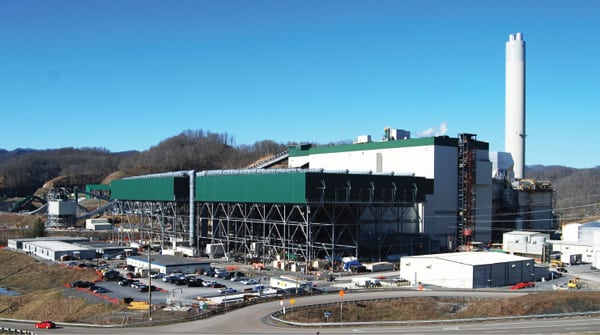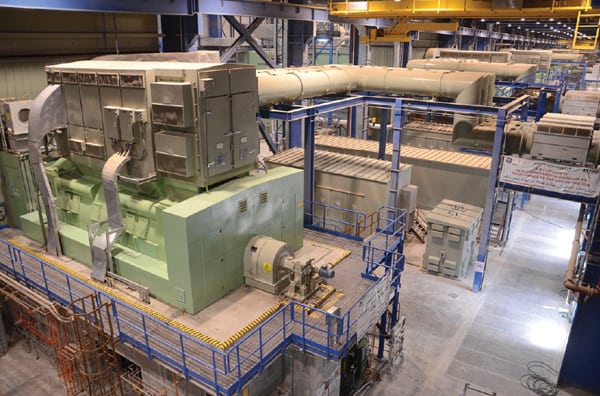Major Projects Commissioned in the U.S., Kuwait, and India
Several major power plants around the world began operations over the past months. Dominion Virginia began commercial operation of its $1.8 billion coal- and biomass-fired Virginia City Hybrid Energy Center in southwestern Virginia, Kuwait completed the second phase of its 2,000-MW combined cycle Sabiya plant, and India’s Tata Power completed construction of the second 800-MW “ultramega” coal-fired power project.
Dominion Begins Operations at New Coal-and-Biomass Power Station. St. Paul, Va.–based Dominion Virginia Power opened its much-awaited 585-MW Virginia City Hybrid Energy Center on July 10, on budget, following four years of construction. The circulating fluidized bed (CFB) project will use run-of-mine coal, waste coal, and biomass (waste wood) to help meet a regional demand surge of nearly 4,000 MW by 2022 that has been projected by grid operator PJM Interconnection (Figure 6).
 |
| 6. Going against the tide. Amid a rash of coal plant retirements, Dominion Virginia Power began commercial operations at its $1.8 billion Virginia City Hybrid Energy Center in July, a 585-MW circulating fluidized bed facility that will combust run-of-mine coal, waste coal, and biomass (waste wood). Courtesy: Dominion Virginia Power |
At the plant, two CFB boilers supply steam to a single turbine generator. The CFB combustion process recirculates unburned fuel, which increases heat transfer and performance. “Technologies such as selective noncatalytic reduction systems and the use of limestone, coupled with a dry scrubber, further eliminate environmentally harmful chemicals,” said Shaw, which designed the plant and served as its engineering, procurement, and construction contractor. The project included construction of a solid waste management facility designed for the exclusive disposal of coal combustion byproducts associated with power generation from the plant.
The project was initiated in 2006 in response to legislation enacted by the 2004 Virginia General Assembly, which encouraged the development of a clean coal–powered electric generation facility that uses Virginia coal and is located in the Southwest coalfield region of the commonwealth. Assured that the project would expand electric capacity to meet growth in the commonwealth and promote economic development in southwest Virginia, the State Corporation Committee, in a final order dated Nov. 1, 2006, determined that construction of this facility was in the public interest.
Virginia City is only one of a dozen coal-fired power plants to enter service in recent years, owing to tighter environmental rules, higher coal prices, lower natural gas prices, and slower economic growth. Last year, six new units at five coal plants (a total capacity of 2,343 MW) came online, but only 10 coal-fired power plants were under construction as of January 2012, a Department of Energy update shows. Only one project was progressing to the “near construction” stage, and 13 were in the permitting stages. A total of 24 coal plants (1,599 MW) were in the early stages of development, while announced projects represents 2,890 MW had been canceled.
Meanwhile, the Energy Information Administration (EIA) forecasts in its Annual Energy Outlook 2012 reference case that 49 GW of coal-fired capacity—nearly a sixth of existing capacity in the U.S.—may be retired through 2020. Most projected retirements are older, inefficient units, primarily concentrated in the mid-Atlantic, Ohio River Valley, and southeastern U.S., where the EIA says “excess electricity generation capacity” currently exists.
Perhaps more critically, in its latest Form EIA-860 “Annual Electric Generator Report,” the EIA suggests that almost 27 GW of capacity from 175 coal-fired generators will be retired between 2012 and 2016. In 2011, there were 1,387 coal-fired generators in the U.S., totaling almost 318 GW. That means, as the EIA points out, coal-fired capacity expected to be retired over the next five years is more than four times greater than retirements during the preceding five-year period (6.5 GW). This year alone, 9 GW of coal plant retirements will occur, and this will “likely be the largest one-year amount in the nation’s history.” The record is, however, expected to be short-lived, as almost 10 GW of coal-fired capacity are expected to retire in 2015.
GE Completes Phase Two of 2-GW Kuwaiti Gas Plant. In Kuwait City on July 24, Kuwait’s government and GE Energy completed phase two of the 2,000-MW Sabiya combined-cycle power plant project in time to meet the country’s peak demand during the hot summer months. GE last June installed six GE 9FA gas turbines at the government-owned plant in phase one, and they have operated initially in simple cycle mode to add nearly 1,400 MW to the country’s grid, which is seeing power demand surging at about 7% to 10% per year (Figure 7).
 |
| 7. Stepping on the gas. Kuwait’s Ministry of Electricity & Water completed and commissioned phase two of its Sabiya combined cycle power plant project in time for peak summer demand. The second phase involved boosting the plant’s output to more than 2,000 MW. This image shows the plant’s turbine room. Courtesy: GE Energy |
Phase two involved boosting the plant’s output to more than 2,000 MW by upgrading the plants to combined cycle mode. This increased Kuwait’s generating capacity by nearly 20%, said GE, which built the plant with South Korea’s Hyundai Heavy Industries.
Tata Begins Operations at Second UMPP Unit. Tata Power, India’s largest power producer, in mid-July kicked off operations at a second 800-MW unit located at the Mundra Ultra Mega Power Project (UMPP) in the western state of Gujarat. The first unit of the UMPP, fired by coal imported from Indonesia, was commissioned in March.
The unit is expected to add critical capacity to alleviate the country’s chronic power shortages. On July 30 and 31, the country saw unprecedented back-to-back failures of its Northern, Eastern, and Northeastern grids that slashed power to more than 60% of the country’s population in an area that stretched 2,000 miles from Assam, near China, to the Himalayas and the northwestern deserts of Rajasthan. The Western and Southern grids were unaffected.
The blackouts were blamed on several issues assailing the country’s power infrastructure. The country has been grappling with a critical coal shortage that has forced privately owned and money-strapped state-owned coal generators alike to rely on expensive imports from Indonesia and South Africa. Natural gas is also in short supply in India, forcing gas power plants to operate at load factors of around 58% to 60%. A drought that has strained the northern regions’ hydropower supply was compounded by a spike in power demand, resulting in an overall average peaking shortage of about 12% and prompting some states to overdraw power, despite penalties, from regional grids. Experts have warned that the country faces more crippling blackouts owing to its fragile and overstretched electricity network.
The state of Gujarat, which actually enjoys a surplus as a result of sweeping power reforms, was reinforced by the Western Grid and escaped the blackouts. Just a decade ago, news media painted the state’s energy sector as “grim,” unable to attract private investment. Reforms reportedly began when Narenda Modi took over as state’s chief minister in October 2001, first shuffling leadership at the bankrupt Gujarat State Electricity Board (GSEB) and then unbundling it and focusing on restructuring the power utility’s finances.
The state then embarked on renegotiating power purchase agreements with private firms, separating feeder lines that supplied subsidized power for agricultural users from non-agricultural users to make farm power rationing effective and tamper-proof, and stringently policing rampant power theft, which reportedly had ranged from 20% in urban areas to as high as 70% in rural regions. Within five years, media say, GSEB posted its first profit, transmission and distribution losses had fallen to 20%, and tariff collection efficiency neared 100%. The reforms set the stage for an increase in investment by private power firms like Tata, despite the state’s sizeable distance from the nation’s coal mines.
But like other Indian coal generators, Tata, which won the Mundra UMPP through competitive bidding, now imports much of its coal and has asked the federal electricity regulatory commission, CERC, to increase power tariffs for power generated from the plant. Tata said that recent changes in Indonesian fuel pricing regulations have put the UMPP at risk of turning financially nonviable.
—Sonal Patel is POWER’s senior writer.